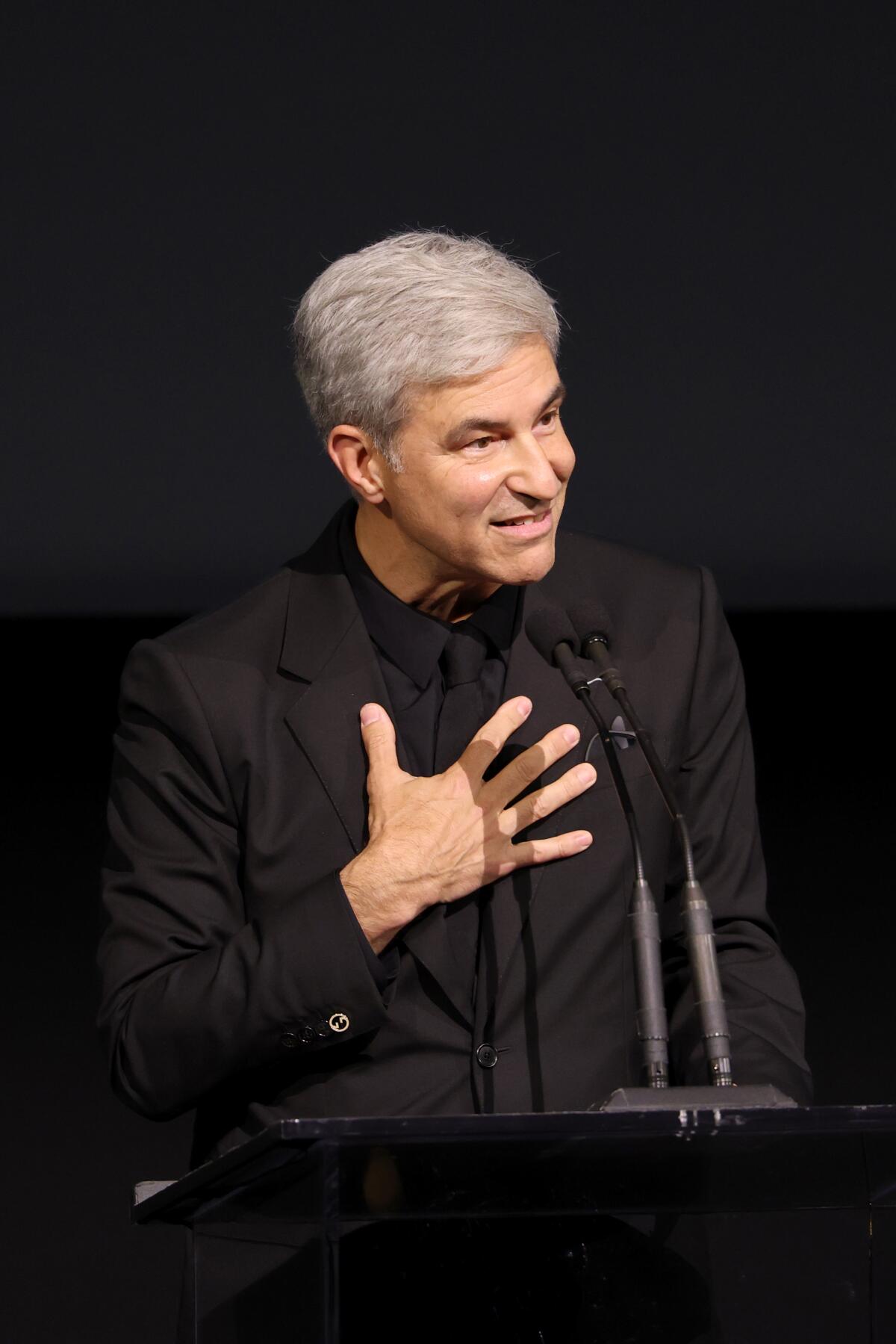Dodgers win electrifies LACMA’s starry Art + Film gala with Cynthia Erivo, George Lucas
When Los Angeles County Museum of Art director Michael Govan first stepped up to the podium at the museum’s star-packed 14th annual Art + Film Gala, the Dodgers were down one point to the Toronto Blue Jays in the eighth inning of the final game of the World Series.
There was no giant screen in the massive tent where a decadent dinner was being served Saturday night in celebration of honorees artist Mary Corse and director Ryan Coogler. Instead guests in elaborate gowns and tuxedos discreetly glanced at their phones propped on tables and at the base of flower vases across the star-packed venue. This became apparent when Miguel Rojas hit a game-tying home run at the top of the ninth inning and the whole room erupted in cheers.

Michael Govan, CEO of LACMA, wearing Gucci, speaks onstage during the 2025 LACMA Art+Film Gala.
(Amy Sussman / Getty Images for LACMA)
When Govan returned to the stageto begin the well-deserved tributes to the artist and filmmaker of the hour, the game had been won, the effusive cheering had died down, and the phones had been respectfully put away.
“Go Dodgers!” Govan said, before joking that LACMA had engineered the win for this special evening. The room was juiced.
It made Los Angeles feel like the center of the universe for a few hours and was fitting for an event that famously brings together the city’s twin cultural bedrocks of art and cinema, creating a rarefied space where the two worlds mix and mingle in support of a shared vision of recognizing L.A.’s immeasurable contributions to the global cultural conversation.
“This is a celebration that can only happen in L.A. — where art, film and creativity are deeply intertwined,” Govan said. “I always say this is the most creative place on Earth.”
The event raised a record $6.5 million in support of the museum and its programs. Co-chairs Leonardo DiCaprio and LACMA trustee Eva Chow hosted a cocktail party and dinner that drew celebrities including Dustin Hoffman, Cynthia Erivo, Cindy Crawford, Queen Latifah, Angela Bassett, Lorde, Demi Moore, Hannah Einbinder, Charlie Hunnam and Elle Fanning alongside local elected officials and appointees including U.S. Rep. Sydney Kamlager-Dove (D-Los Angeles); L.A. County Supervisors Holly Mitchell and Lindsey Horvath; L.A. Councilmember Katy Yaroslavsky; West Hollywood Councilmember John M. Erickson, and Kristin Sakoda, director of the Los Angeles County Department of Arts and Culture.
Sakoda said she thoroughly enjoyed the festivities “as representative of the incredibly diverse culture of Los Angeles and how that speaks to our entire nation.”



1. George Lucas arrives at the LACMA Art + Film Gala on Saturday. (Jordan Strauss / Invision via Associated Press) 2. Elle Fanning arrives at the LACMA Art + Film Gala on Saturday. (Jordan Strauss / Invision via Associated Press) 3. Angela Bassett arrives at the LACMA Art + Film Gala on Saturday. (Jordan Strauss / Invision via Associated Press)
A special nod of gratitude went to previous gala honorees in attendance including artists Mark Bradford, James Turrell, Catherine Opie, Betye Saar, Judy Baca, George Lucas and Park Chan-Wook. Leaders from many other local arts institutions also showed up including the Hammer Museum’s director, Zoe Ryan; California African American Museum Director Cameron Shaw; and MOCA’s interim Director Ann Goldstein.
Rising in the background was LACMA’s new David Geffen Galleries, the 110,000-square-foot Peter Zumthor-designed building scheduled to open in April as the new home for the museum’s 150,000-object permanent collection.
“Every day I’m in that little building behind installing thousands of artworks,” Govan said to cheers. “I can’t wait for people to rediscover our permanent collection, from old favorites to new acquisitions. It’s a monumental gift to L.A., and in addition to L.A. County and the public, I would like to thank the person whose generosity brought us to this landmark moment, Mr. David Geffen.”
Geffen sat in a sea of black ties and glittering gowns, near Disney CEO Bob Iger and DiCaprio — who had been filmed earlier in the week in attendance at Game 5 of the World Series at Dodger Stadium.
Govan also gave a special acknowledgment to former LACMA board co-chair, Elaine Wynn, who died earlier this year and was one of the museum’s most steadfast champions. Wynn contributed $50 million to the new building — one of the first major gifts in support of the effort. Govan noted that the northern half of the building will be named the Elaine Wynn wing.

Honoree Ryan Coogler, wearing Gucci, speaks onstage during the 2025 LACMA Art+Film Gala.
(Amy Sussman / Getty Images for LACMA)
Left unmentioned was the fact that earlier in the week LACMA’s employees announced they are forming a union, LACMA United, representing more than 300 workers from across all departments, including curators, educators, guest relations associates and others. One worker told The Times there were no plans to demonstrate at the gala, which raises much-needed funds for the museum.
The crowd sat rapt as the night’s guests of honor, Corse and Coogler, humbly spoke of their journeys in their respective art forms, with Govan introducing them as “artists whose brilliant groundbreaking work challenges us to see the world differently.”
The night concluded with an enthusiastic performance by Doja Cat on an outdoor stage in the shadow of the David Geffen Galleries, the lights girding its massive concrete underbelly like stars in the sky.
“It was a beautiful evening of community coming together around something that reminds us of our shared humanity at a time when we need it,” said Yaroslavsky with a smile as the evening wound down.
